In the unrelenting stream of videos showing violent police encounters with citizens, none has carried more sheer power to stun the public than the shooting death of Walter Scott in North Charleston, South Carolina. Officer Michael Slager initially said Scott wrestled with him and tried to take his Taser. But the video told a disturbingly different story as it captured Slager firing eight times at a fleeing Scott, hitting him five times in the back. Slager was promptly charged with murder once the bystander video surfaced.
Recordings of police encounters have demonstrated their impact since home video caught Los Angeles Police officers beating Rodney King in March 1991. When George Holliday, who videotaped the King beating, offered the footage to the LAPD, an officer expressed no interest. If only that sergeant had known. Holliday then took his video to a television station.
Videos capturing the chokehold death of Eric Garner at the hands of a New York Police officer and the roadside beating of Marlene Pinnock by a California Highway Patrol officer are only some of the more recent examples of video that has proved critical in allowing the public to judge for itself whether police acted properly.
Though so many adults now have smartphones with video cameras, people exercise the right to record the police far less than they could or should. Some people don’t know the right exists. Others are intimidated by officers who mistakenly believe that recording a police encounter is unlawful. These officers may threaten to arrest them. The bystander who recorded the Scott shooting was so fearful of possible police retaliation that he considered erasing his video. Still others fear recording an encounter won’t make a difference because they assume police officers will confiscate their phone and delete the video.
The ACLU of California has moved to ease those concerns with the launch of Mobile Justice CA, a free smartphone application allowing people to record video that is sent straight to local ACLU offices. This transmission is key because it prevents anyone from grabbing the phone and deleting the only copy of the video. The app, available on Apple and Android phones, also enables the Android phone screen to lock as soon as the video stops recording to protect that footage if the phone is confiscated.
The app enables a user to receive notifications if someone nearby is using it to record. It also sends such notifications to others when someone is recording with the app, bringing more witnesses to the scene. Last, the app contains Know Your Rights information, educating individuals about their rights, including the right to record the police. We hope that these functions, individually and collectively, provide reassurance against officers who seek to intimidate or discourage people from exercising their rights.
The app provides a needed tool for accountability. Often incidents of serious misconduct go unreported because people don’t feel that they will be believed in the game of “he said, she said” that often results. Worse yet, other incidents go without remedy because the only person who can contradict the officer’s version is dead. A federal judge has described such encounters as the game of “we said, he’s dead.” With Mobile Justice CA, the technology empowers the people to document police activity and directly place a check on police power: users are encouraged to submit a detailed incident report of a law enforcement interaction they saw or experienced, whether or not they recorded it.
Video technology may also serve as a practical deterrent. In a recent study, police officers wearing body cameras, for example, were shown to be more than 50 percent less likely to use force. This makes sense. People behave better when they know they are being watched. By multiplying the number of cameras that can be trained on police, the app promises to deter bad behavior and improve police interactions with the public.
The courts have decided for decades that the right to gather information that can be made publicly available about government officials serves a key purpose of the First Amendment. Such activity promotes the free discussion of government affairs. This right is particularly critical when applied to the conduct of law enforcement officers and their extraordinary powers to detain, search, arrest or use force – powers that may be misused to deprive people of their rights, liberties or their very lives. Public scrutiny of the police guards against the abuse of power and the miscarriage of justice. The people’s well-established First Amendment right to record police conduct is a cornerstone of that scrutiny.
Though the national debate around police abuse has naturally focused attention on the app’s value as a check on law enforcement abuse – whether by police officers, sheriff’s deputies, border patrol, or other officers – we know the app can be used more broadly to record or document other abuses.
The ACLU of California was able to develop the app thanks to the generosity of Susan Adelman and Claudio Llanos.
The ACLU of California is a collaboration of the three ACLU affiliates in the state—the ACLU of Northern California, the ACLU of Southern California, and the ACLU of San Diego & Imperial Counties.
Hector Villagra is executive director at the ACLU of Southern California. Follow ACLU_SoCal



